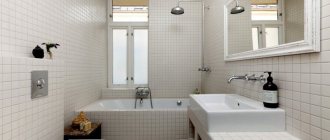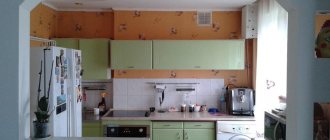Installing a washing machine (WM) in the kitchen is often a necessary measure, because... there was simply no room for it in the small bathroom. And sometimes such an arrangement is a deliberate step, if it is convenient to place all the equipment in a house or apartment in one place.
There were other advantages
:
- additional work surface. As a rule, SM is installed under a countertop on which you can cook;
- a small bathroom without a machine will become free and convenient to use.
Washing machine in the kitchen, built into the end of the kitchen unit
. Of the minuses:
- the need for camouflage (especially in kitchens with a classic design, where SM does not fit at all);
- proximity of washing powder to food;
- the need to carry dirty laundry to the kitchen every time you wash;
- the need to select and prepare a place for installation in advance.
Kitchen with built-in SM under the countertop
Despite all the listed inconveniences, the housewife will eventually get used to this arrangement. Important questions remain: how to integrate a washing machine into a kitchen unit so that it does not violate the stylistic unity, and its use is comfortable. We'll talk about this in more detail later.
Features of accommodation
The main reason why they decide to install a unit in the kitchen is to free up space in the bathroom.
There are a number of other positive aspects:
- Safety. There is much less humidity in the kitchen than in the bathroom;
- Aesthetic appearance. Kitchen appliances can be hidden behind furniture fronts. Then the laundry intended for washing will not be visible. Even when the machine door is slightly open after the washing process, no one will see it. Everything will be hidden behind facades;
- Possibility of installing large-sized machines. Not every bathroom can accommodate such a model, but its placement in the kitchen is possible. What is the advantage of such a model? Washing in it is carried out more efficiently, in addition, the large drum of the unit allows you to accommodate a large volume of laundry.
- In addition, the models are characterized by increased stability due to the installed counterweight at the bottom of the unit. This also results in less vibration and noise.
There are also disadvantages to a kitchen with a washing machine. There are not many of them, but they are available:
The system for washing textiles does not fit well into the interior. Groceries, unwashed laundry, and a slightly open door do not make the interior immaculate.
You can get rid of these unpleasant moments if you carefully think through the future facade and make convenient niches for storage.
High installation
Connecting the washing machine is not everything. You also need to consider the convenience of subsequent use.
We recommend placing the machine higher up, not on the floor, to make it easier to load things. A good example is in this photo.
This way you won't have to bend over every time you need to wash.
Built-in options
There are many ways to integrate a machine into the kitchen. A considerable part of them involve maintaining the integrity of the style and camouflaging the washing machine. Before purchasing household appliances, it is recommended to remove the parameters so that the machine fits the prepared niche.
There are both standard and unusual placement techniques. For example, a washing machine in the kitchen under the countertop.
When choosing a suitable location, it is important to consider three factors:
- Distance from the stove, refrigerator, and dishwasher. The vibration of these household appliances contributes to the failure of the fans and compressors built into the unit.
- Providing space for filling and unloading washed items from the machine (at least 1 sq.m.).
- Free access to hoses for maintenance or repair.
From an engineer's point of view
In the process of connecting an automatic washing machine, the following engineering systems are important:
- water pipes;
- sewerage;
- power supply
In order for the device to operate efficiently and economically, it is necessary to provide a supply of cold water that meets all quality standards. Used water must be discharged to the sewer. Electricity is supplied from a reliable source of sufficient (with a small margin) power.
For stable and durable operation, tap water with the lowest hardness level is ideal. If your water has doubts regarding such qualities as hardness and purity, then before entering it into the washing machine it is recommended to install appropriate filters, which must be periodically replaced as they become dirty.
The sewer system of an apartment building fully meets the requirements for organizing the drainage of waste water. In private buildings there are also no problems, provided that standard pipelines and shaped fittings are used.
Electrical connections must be made without the use of extension cords, low-quality connectors and non-standard parts. It is better if the power cable is connected to the nearest outlet with a grounding conductor and a residual current device (RCD) on the line.
Full embedding
At the stage of creating a kitchen unit project, you should consider the type of built-in option. It is necessary to measure the dimensions of the equipment, and take them into account when drawing up the design of the headset. Full integration means that the equipment is hidden behind furniture facades.
This technique is typical for models with a standard side hatch. In the photo of the washing machine in the kitchen you can see different options for fully integrating the equipment.
Placement in a cabinet
A common way of arranging a kitchen set is to divide it into two parts, where wall cabinets, a stove, and a countertop are included in the first part, and the second independent part includes a cabinet with a sink and a machine, placed along the side wall.
This arrangement contributes to the convenience of connecting the unit and a long service life.
Under the table top
It is popular to integrate a washing machine into a so-called “pocket”. In other words, this is an equipped part of the area for placing the unit under the countertop, which is fixed on both sides.
The advantage of this technique is that it does not require fundamental changes in furniture. If desired, the machine can be easily moved and then put back in its original place. Having chosen this option, there is no need to place the machine in the center of the kitchen, which is very important when planning.
Technical details of the process
The connection for all installation options follows approximately the same algorithm, no matter whether you decide to install the unit in a bathroom cabinet or in a kitchen unit, under a countertop or under a sink. In any case, you should proceed step by step:
- Consider how to connect to the water supply.
- Create a drain for used water.
- Make electrical wiring (it is advisable to install a moisture-resistant socket).
- Make sure that all specified communications can be connected to the machine.
- Check the length of the hoses and power cord so that the device can be conveniently pulled out of the niche in which it is placed.
- Connect the unit to the water supply and sewer pipes.
- Push the machine into the designated place and secure the legs.
When installing a washing machine under a countertop, you must carefully calculate the dimensions of the future niche. There should be a gap of 3-5 cm between the unit and the walls of the furniture so that unnecessary noise does not occur during vibration.
Built-in appliances can be an attractive design element in a kitchen or bathroom. If you show maximum imagination, you will be able to turn the disadvantages of the room into advantages, and the result of the work performed will pleasantly surprise you.
Washing machine plus refrigerator
Arranging all your preferred equipment in a small space while observing safety rules is a real challenge. The main thing is to think through all the options for kitchen design with a washing machine and refrigerator. In dead-end situations, it is better to use design services.
Kitchen interior planning begins with the refrigerator, as the most massive object. The refrigerator is usually placed in a corner or at the entrance to the kitchen area.
When installing, you must adhere to the following recommendations:
- There should be a distance of 50 cm between the “work triangle”, which consists of a refrigerator, stove and sink;
- The refrigerator must not be installed next to heating appliances;
- When installing the refrigerator, it is important to leave a distance of 2-5 cm.
There is no categorical prohibition on placing a refrigerator next to a washing machine. In this case, the danger is posed by the increased humidity of the unit, but with professional installation, possible problems can be avoided.
A kind of column will help to place a lot of household appliances in the kitchen with a refrigerator and washing machine. It is a pencil case made of several drawers, adapted for installing electrical appliances. A high cabinet can be installed next to the refrigerator.
The most suitable solution for a compact kitchen would be to place a refrigerator in a column next to the washing machine. This design “goes” all the way to the ceiling and makes it possible to rationally use empty space.
Manufacturers of modern household appliances greatly simplify the task for owners of small apartments. In stores you can buy models of different sizes. Furniture makers also help by making custom-made perfect sets according to the customer’s measurements.
Thanks to this, placing a refrigerator and washing machine in a small space will not be a problem.











